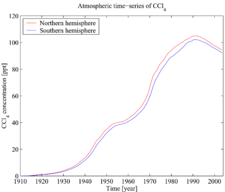
Carbon tetrachloride
Did you know...
SOS Children have produced a selection of wikipedia articles for schools since 2005. SOS Children has looked after children in Africa for forty years. Can you help their work in Africa?
| Carbon tetrachloride | |
|---|---|
 |
 |
|
Carbon tetrachloride |
|
|
Other names
Benziform, Carbon chloride, Methane tetrachloride, Perchloromethane, Carbon tet, Benzinoform, Tetraform, Tetrasol, Freon 10, Halon 104, UN 1846 |
|
| Identifiers | |
| CAS number | 56-23-5 |
| PubChem | 5943 |
| EC number | 200-262-8 |
| KEGG | C07561 |
| ChEBI | CHEBI:27385 |
| RTECS number | FG4900000 |
| Jmol-3D images | Image 1 |
|
SMILES
|
|
|
InChI
|
|
| Properties | |
| Molecular formula | CCl4 |
| Molar mass | 153.82 g/mol |
| Appearance | Colorless liquid |
| Density | 1.5842 g/cm3, liquid 1.831 g.cm-3 at -186 °C (solid) |
| Melting point |
-22.92 °C (250 K) |
| Boiling point |
76.72 °C (350 K) |
| Solubility in water | 0.8 g/L at 25 °C |
| log P | 2.64 |
| Vapor pressure | 11.94 kPa at 20 °C |
| kH | 365 kJ.mol-1 at 24.8 °C |
| Structure | |
| Crystal structure | Monoclinic |
| Molecular shape | Tetrahedral |
| Hazards | |
| MSDS | External MSDS |
| EU classification | Toxic (T), Carc. Cat. 2B, Dangerous for the environment (N) |
| R-phrases | R23/24/25, R40, R48/23, R59, R52/53 |
| S-phrases | (S1/2), S23, S36/37, S45, S59, S61 |
| NFPA 704 | |
| Flash point | Not flammable |
| Supplementary data page | |
| Structure and properties |
n, εr, etc. |
| Thermodynamic data |
Phase behaviour Solid, liquid, gas |
| Spectral data | UV, IR, NMR, MS |
| Except where noted otherwise, data are given for materials in their standard state (at 25 °C, 100 kPa) | |
| Infobox references | |
Carbon tetrachloride, also known by many other names (see Table) is the chemical compound with the formula CCl4. It is a reagent in synthetic chemistry and was formerly widely used in fire extinguishers and as a precursor to refrigerants. It is a colorless liquid with a "sweet" smell that can be detected at low levels.
Both carbon tetrachloride and tetrachloromethane are acceptable names under IUPAC nomenclature. Colloquially, it is called "carbon tet".
History and synthesis
The production of carbon tetrachloride has steeply declined since the 1980's due to environmental concerns and the decreased demand for CFCs, which were derived from carbon tetrachloride. In 1992, production in the U.S.-Europe-Japan was estimated at 720,000,000 kg.
Carbon tetrachloride was originally synthesised in 1839 by reaction of chloroform with chlorine, from the french chemist Henri Victor Regnault, but now it is mainly synthesized from methane:
- CH4 + 4 Cl2 → CCl4 + 4 HCl
The production often utilizes by-products of other chlorination reactions, such as the syntheses of dichloromethane and chloroform. Higher chlorocarbons are also subjected to "chlorinolysis:"
- C2Cl6 + Cl2 → 2 CCl4
Prior to the 1950's, carbon tetrachloride was manufactured by the chlorination of carbon disulfide at 105 to 130 °C:
- CS2 + 3Cl2 → CCl4 + S2Cl2
Properties
In the carbon tetrachloride molecule, four chlorine atoms are positioned symmetrically as corners in a tetrahedral configuration joined to a carbon atom, in the centre, by single covalent bonds. Because of this symmetrical geometry, the molecule has no net dipole moment; that is, CCl4 is non-polar. As a solvent, it is well suited to dissolving other non-polar compounds, fats and oils. It is somewhat volatile, giving off vapors having a smell characteristic of other chlorinated solvents, somewhat similar to the tetrachloroethylene smell reminiscent of dry cleaners' shops.
Solid tetrachloromethane has 2 allotropes: crystaline II below -47.5 °C (225.6 K) and crystaline I above -47.5 °C.
At -47.3 °C it has monoclinic crystal structure with space group C2/c and lattice constants a = 20.3, b = 11.6, c = 19.9 (.10-1 nm), β = 111°.
Uses
In the early 20th century, carbon tetrachloride was widely used as a dry cleaning solvent, as a refrigerant, and in fire extinguishers. However, once it became apparent that carbon tetrachloride exposure had severe adverse health effects, safer alternatives such as tetrachloroethylene were found for these applications, and its use in these roles declined from about 1940 onward. Carbon tetrachloride persisted as a pesticide to kill insects in stored grain, but in 1970, it was banned in consumer products in the United States.
Prior to the Montreal Protocol, large quantities of carbon tetrachloride were used to produce the freon refrigerants R-11 ( trichlorofluoromethane) and R-12 ( dichlorodifluoromethane). However, these refrigerants are now believed to play a role in ozone depletion and have been phased out. Carbon tetrachloride is still used to manufacture less destructive refrigerants.
Carbon tetrachloride has also been used in the detection of neutrinos. Carbon tetrachloride is one of the most potent hepatotoxins, and is widly used in scientific research to evaluate hepatoprotective agents 7,8
Reactivity
Carbon tetrachloride has practically no flammability at lower temperatures. Under high temperatures in air, it forms poisonous phosgene.
Because it has no C-H bonds, carbon tetrachloride does not easily undergo free-radical reactions. Hence it is a useful solvent for halogenations either by the elemental halogen, or by a halogenation reagent such as N-bromosuccinimide.
In organic chemistry, carbon tetrachloride serves as a source of chlorine in the Appel reaction.
Solvent
It is used as a solvent in synthetic chemistry research, but because of its adverse health effects, it is no longer commonly used, and chemists generally try to substitute it with other solvents. It is sometimes useful as a solvent for infrared spectroscopy because there are no significant absorption bands > 1600 cm-1. Because carbon tetrachloride does not have any hydrogen atoms, it was historically used in proton NMR spectroscopy. However, carbon tetrachloride is toxic, and its dissolving power is low. Its use has been largely superseded by deuterated solvents, which offer superior solvating properties and allow for deuterium lock by the spectrometer.
Safety
Exposure to high concentrations of carbon tetrachloride (including vapor) can affect the central nervous system, degenerate the liver and kidneys and may result (after prolonged exposure) in coma and even death. Chronic exposure to carbon tetrachloride can cause liver and kidney damage and could result in cancer More information can be found in Material safety data sheets.
Carbon tetrachloride is also both ozone-depleting and a greenhouse gas. However, since 1992 its atmospheric concentrations have been in decline for the reasons described above (see also the atmospheric time-series figure).


